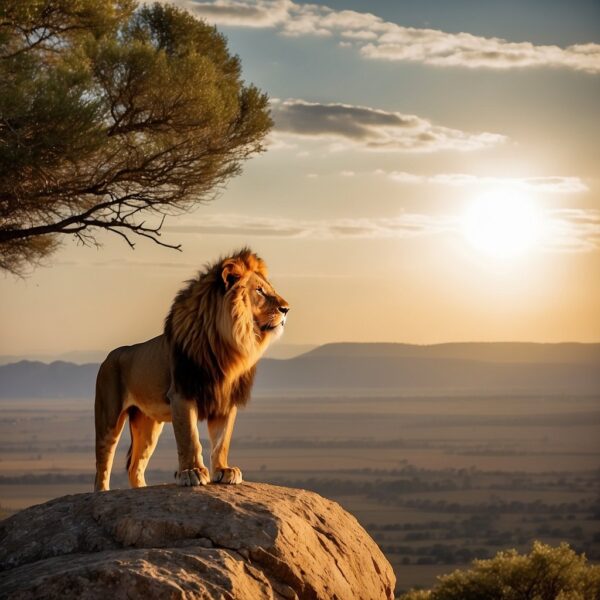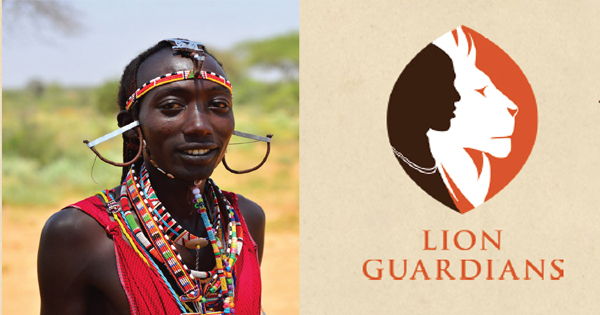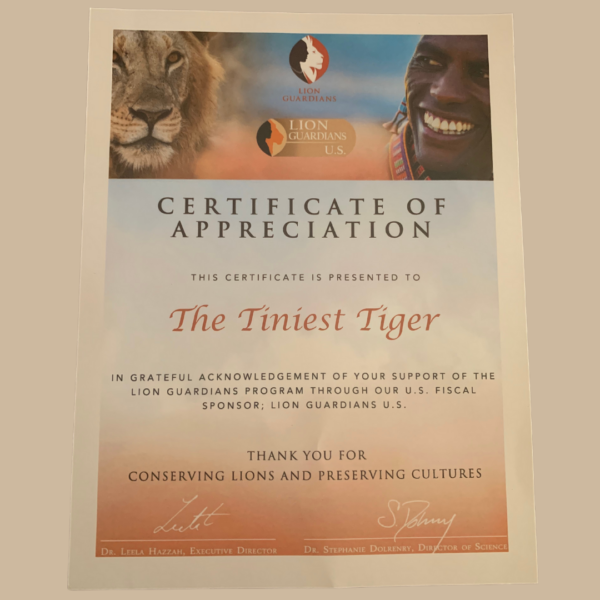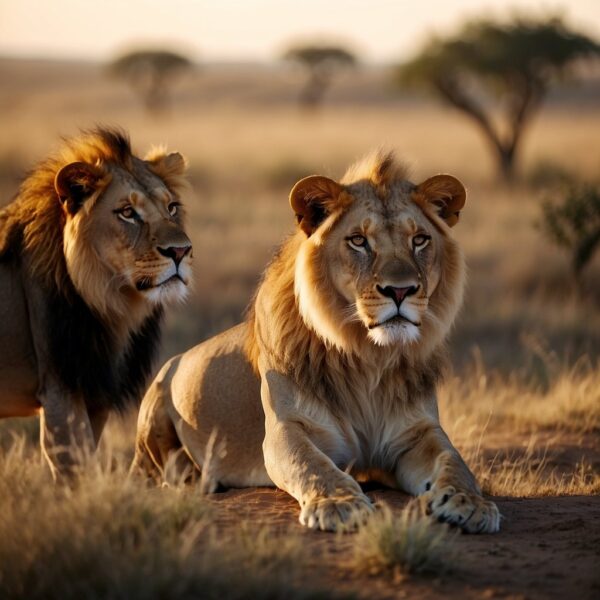
Lion Guardians Project: Promoting Coexistence
Lion Guardians is a conservation initiative that works to ensure the future of African lions and the preservation of the ecosystems they inhabit. Established in 2006, by Leela Hazzah, within the Amboseli-Tsavo ecosystem in Kenya, the project has since expanded its footprint, influencing conservation strategies across multiple countries. The project employs scientific research and leverages local knowledge to promote coexistence between people and lions.
Invoking traditional culture and wisdom, the Lion Guardians Project has developed a model that integrates community-based stewardship with advanced conservation techniques. This unique approach involves training and employing local Maasai warriors, known as “Guardians,” to monitor lion populations, mitigate conflicts, and disseminate education about lion behavior to the community. The engagement of Guardians in direct conservation roles not only protects wildlife but also forges a symbiotic relationship between human communities and the natural world they share.
Key Takeaways
- The Lion Guardians Project is a community-based conservation initiative focused on the African lion.
- It blends traditional knowledge with scientific research to foster human-wildlife coexistence.
- Local involvement and progressive techniques have been key to its continued success and expansion.

lion guardians Origins and Mission
The Lion Guardians project, born out of necessity, has been pivotal in transforming lion conservation efforts. By integrating indigenous knowledge with modern science, it has charted a successful path in both protecting lions and empowering local communities.
Emergence of Lion Guardians
Lion Guardians began in 2006, an initiative rooted within the Amboseli-Tsavo ecosystem in Kenya. It was a response to the escalating conflict between the Maasai community and lions, addressing a crisis that threatened both the community’s livelihoods and the survival of the lion population. The program originated with just five Guardians, but its effectiveness has seen it extend across multiple countries.
Objectives and Philosophy
At its core, the Lion Guardians project is driven by two main objectives:
- Lion Conservation: To stabilize and increase lion populations, ensuring the species’ longevity and genetic diversity.
- Community Empowerment: To engage and empower the local Maasai communities, enabling them to coexist peacefully with lions.
The philosophy of Lion Guardians hinges on a balance between scientifically-driven solutions and traditional practices, ensuring relevancy and sustainability. Its success in various regions attests to the adaptability and transferability of its methods. The operational footprint of Lion Guardians in Amboseli spans approximately one million acres, illustrating a large-scale commitment to their mission.

Conservation Efforts
The Lion Guardians Project emphasizes sustainable practices in wildlife conservation with a particular focus on the Amboseli-Tsavo ecosystem. By prioritizing effective monitoring, lion population management, and habitat preservation, the project seeks long-term solutions for coexistence between people and lions.
Wildlife Monitoring
Lion Guardians employs community-based approaches to monitor wildlife, especially lions. This involves training and engaging local communities to track lion movements, behavior, and health. They utilize scientific methods and technology to collect data, vital for making informed decisions on lion conservation efforts.
- Techniques used:
- GPS tracking
- Field observation
- Community reports
Lion Population Management
The goal of lion population management is to foster a stable and healthy lion population within the Amboseli-Tsavo ecosystem. Lion Guardians focuses on conflict mitigation techniques which discourage lions from preying on livestock, and community education to reduce retaliatory killings.
- Strategies employed:
- Building predator-proof enclosures
- Community engagement and education
Habitat Preservation
Habitat preservation efforts by Lion Guardians involve protecting and managing the natural resources and habitat critical for lions and other wildlife. This includes mitigating human-wildlife conflicts and promoting practices that ensure a balance between community land-use and wildlife conservation.
- Initiatives undertaken:
- Rangeland management
- Promoting sustainable land-use practices

Human-Wildlife Relations
The Lion Guardians Project is a beacon for successful human-wildlife coexistence, effectively reducing conflict between human communities and lions through a multifaceted approach involving conflict mitigation, community involvement, and education and awareness.
Conflict Mitigation
The cornerstone of the Lion Guardians Project is the reduction of human-lion conflicts. With substantive measures, the project has halved livestock losses and decreased lion mortality rates in retaliation strikes. Strategies like reinforcing livestock enclosures are vital in preempting potential encounters between lions and domestic animals, drastically reducing the likelihood of harmful incidents.
Community Involvement
Community engagement has been pivotal. The project empowers local communities, particularly by transforming former lion hunters into protectors. These guardians are instrumental in deploying traditional knowledge and techniques in service of the broader goal of lion conservation. Their on-the-ground actions ensure that both community and wildlife interests are considered and safeguarded.
Education and Awareness
Education initiatives form another critical aspect of Lion Guardians’ work. They elevate community understanding of the value of lion species and the importance of preserving them. Through educating communities about the benefits of wildlife conservation and sustainable practices, Lion Guardians facilitate a shift in perception that promotes a deeper respect and a durable coexistence between people and lions.
Cultural Integration
The Lion Guardians Project successfully intertwines the conservation of lions with the reverence of Maasai cultural practices, placing emphasis on the integration of traditional knowledge and modern conservation methods. It leverages the deep-rooted values of the Maasai community to foster a harmonious coexistence between people and wildlife.
Incorporating Maasai Values
At the heart of the Lion Guardians Project lies a profound respect for the Maasai way of life. Central to this is the Maasai’s intricate relationship with their livestock, which is a critical component of their economic and social fabric. Traditional knowledge of the Maasai is harnessed, transforming the role of Maasai warriors—once lion hunters—into protectors of the lions. They are pivotal in conflict prevention, using their understanding of both lion behavior and the grassland ecosystem to mitigate encounters between lions and humans.
- Maasai warriors are trained and employed as Lion Guardians.
- They monitor lion movements and warn communities of their presence.
- Lion Guardians partake in recovering lost or stray livestock, an act that directly benefits their communities and reduces the likelihood of retaliatory hunts.
Revolutionizing Local Perception
The Lion Guardians Project has been instrumental in reshaping local perceptions of lions. By employing Maasai warriors as Lion Guardians, the project showcases a shift from viewing lions solely as threats to recognizing their value in the natural ecosystem and their importance to Maasai heritage. Through community outreach and education, the initiative demonstrates the benefits of lion conservation, contributing to increased tolerance and decreased killings of lions.
- Educational programs emphasize the importance of lions to the Maasai cultural identity and the larger ecosystem.
- Success stories of coexistence are shared to illustrate the positive outcomes of cultural integration in lion conservation efforts.
- The project provides tangible examples of how Maasai traditional knowledge can coexist with, and indeed enhance, wildlife conservation.
Research and Knowledge
The Lion Guardians program is underpinned by a foundation of vigorous data collection and intensive lion behavior studies. The accumulation and analysis of empirical data not only inform their conservation strategies but also contribute to the broader field of wildlife management.
Data Collection
The Lion Guardians methodically gather data that accounts for lion population dynamics and the frequency of interactions with livestock. They maintain detailed records which include:
- Sightings: Monitoring lions via GPS trackers and manual tracking techniques.
- Incidents: Documenting encounters between lions and humans, especially around homesteads.
- Livestock: Recording instances of predation to assess the risk to local herders’ livelihoods.
The data serve as a critical resource for developing proactive measures to minimize human-lion conflict and enhance community-based stewardship of wildlife.
Lion Behavior Studies
The organization conducts in-depth studies into lion behavior, which is key to understanding the factors leading to conflict with humans. Key areas of focus include:
- Territorial patterns: Insight into the areas where lions are most active helps predict their movements.
- Hunting practices: Analysis of lions’ predation on wild prey versus livestock aids in informing local herders on how to safeguard their livestock effectively.
Through continuous behavior studies, the Lion Guardians can fine-tune their conservation tactics, ensuring that both the lion population and local livelihoods are preserved.

lion guardian Protective Measures
The Lion Guardians Project implements specific strategies to mitigate human-wildlife conflict by monitoring lions and enhancing livestock defense mechanisms.
Lion Tracking and Alerts
The project employs lion tracking to monitor the movements of lions, especially those that are collared with GPS equipment. This allows the Lion Guardians to track lion movements and alert communities in advance, helping them prepare and reduce potential confrontations between humans and lions. Data from the collared lions are essential in understanding lion behavior and territory usage.
Livestock Protection Strategies
Livestock protection forms the second pillar of the protective measures. The Lion Guardians advise on and help implement strategies to better protect livestock, which include:
- Reinforced Enclosures: Upgrading traditional livestock enclosures to reduce vulnerability to predator attacks.
- Predator Deterrents: Using non-lethal tools, like flashing lights, to keep lions away from livestock areas at night.
By improving these measures, the project not only safeguards the livestock of local communities but also reduces the instances of retaliatory killing of lions.
Sustainability and Growth
The Lion Guardians Project has shown remarkable progress in lion conservation, securing the future of these majestic creatures through a unique blend of local involvement and international support. Growth is evident across their operations, which now encompass close to a million acres, particularly within the Amboseli ecosystem.
Local and Global Support

Financial contributions play a critical role in the sustainability of conservation efforts. The Lion Guardians Project benefits from a diverse range of support systems, from individual donations to organizational backing. Here is a breakdown of the support mechanisms:
- Donations: Individual contributions provide financial resources necessary for field equipment and operations.
- Funding Organizations: Groups like the Maasailand Preservation Trust offer substantial support, reinforcing the project’s ability to maintain and expand its activities.
Future Directions for lion guardian Expansion
The project’s expansion strategies focus on enhancing lion survival rates and fostering lion conservation best practices, both locally and in similar environments globally. Key aspects of the planned expansion include:
- Strengthening Local Capacity: Developing community-led management to ensure that the Amboseli ecosystem remains a stronghold for lion conservation.
- Scientific Research: Leveraging scientific insights to improve conservation strategies and measure success metrics such as lion density and conflict reduction.
Through concerted efforts, the ambition to replicate the Lion Guardians model in other regions reflects a strong commitment to both local empowerment and the broader objectives of global conservation.
lion guardian Collaborative Initiatives
The Lion Guardians Project thrives through strategic partnerships and a shared knowledge base, emphasizing the significance of unified efforts in conservation.
Partnerships and Alliances
Lion Guardians has established robust partnerships with multiple stakeholders, including local communities and conservation organizations. These alliances have been instrumental in expanding the project’s reach beyond its core in Tanzania and facilitating community-based conservation efforts across various regions. By working closely with entities like Technology for Conservation (T4C), Lion Guardians has enhanced its technological capabilities to monitor and protect lions effectively.
Shared Resources and Training
The organization places a strong emphasis on the mobilization of resources and the provision of specialized training programs. These initiatives are grounded in the recognition of local communities as vital to the conservation process. Training programs focus on conflict mitigation and aim to empower community members with the skills necessary for living with lions harmoniously. The sharing of open-source conservation tools and methodologies has further scaled the impact of the Lion Guardians’ work, amplifying their conservation footprint.
Challenges and Adaptation
The Lion Guardians Project operates in complex environmental and social landscapes, dealing with issues such as lion killing and human-wildlife conflict. It continuously evolves strategies to mitigate these challenges and adapts to the dynamic conservation needs of the region.
Dealing with Retaliation
One pressing issue for the Lion Guardians is retaliation against lions. In areas like Southern Olgulului, when lions predate on livestock, affected communities may organize hunting parties seeking revenge. This not only poses a direct threat to lion populations but also exacerbates tense situations. To address this, Lion Guardians employ various measures such as:
- Intervention: They promptly intervene when there is a loss of livestock to prevent retaliatory hunting.
- Education: They educate communities on the value of lions within the ecosystem to reduce the desire for retaliation.
The success of these efforts is evidenced by an over 80% decrease in the number of lions killed by community members in areas where the Lion Guardians operate compared to prior to the organization’s founding.
Navigating Conservation Challenges
Navigating conservation in the face of human-wildlife conflict requires innovation and perseverance. Lion Guardians have adapted by:
- Community Engagement: They include local communities in conservation efforts, especially when there’s a tense atmosphere due to livestock loss or lion presence.
- Conflict Prevention: Proactive measures such as tracking of lion movements and recovering lost livestock help mitigate potential conflicts.
Through these adaptations, the organization has achieved a remarkable average of 90% reduction in lion killing. Their work has also made considerable strides in changing local perceptions of lions, which is a significant step toward sustainable coexistence.
lion guardians: Long-term Impacts
The Lion Guardians project has been pivotal in facilitating a sustainable coexistence between humans and wildlife in Southern Kenya, particularly where carnivores are concerned. Long-term impacts of this initiative are evident in the marked reduction of conflicts and the promotion of ecological balance.
Carnivores in the Ecosystem
Carnivores play an essential role in maintaining the health and balance of ecosystems. Through the efforts of the Lion Guardians project, the carnivore population in the Amboseli-Tsavo ecosystem has experienced substantial changes. For instance, the lion population, which is a key indicator species for the health of the ecosystem, has stabilized to approximately 160 individuals. This stabilization is a direct result of the project’s interventions that have seen a dramatic reduction in the spearing of these big cats.
Key Highlights:
- Stabilized population of around 160 lions
- _ Over 80% reduction in lions killed by community members _
Community-Ecosystem Dynamics
The success of the Lion Guardians project has rested on the integral involvement of the local communities, especially the Maasai people who share their land with carnivores. Community members have been enlisted and trained as ‘Guardians,’ who not only protect the lions but also recover lost livestock, reducing economic losses for the locals. This innovative, collaborative approach has directly led to a decrease in lion mortality due to human conflict in the region. Locals now find increased value in the preservation of carnivores, understanding their importance to the environment and to the concept of an ecologically balanced habitat.
Outcomes:
- Established value in preserving carnivores among local communities
- Found 29,408 lost livestock, mitigating economic losses
- Facilitated the recovery of 13 lost individuals

Frequently Asked Questions about lion guardians
The Lion Guardians program is pivotal to lion conservation, integrating community-based strategies to protect the lion population and mitigating human-wildlife conflict.
What are the primary objectives of the Lion Guardians program?
The principal aim is to devise sustainable, scientifically-driven solutions for the coexistence of lions and human communities, particularly by reducing the incidences of retaliatory killing of lions.
How do Lion Guardians contribute to lion conservation?
Lion Guardians monitor lion movements, warn herders of lion presence to prevent attacks on livestock, and recover lost livestock, all of which decrease the likelihood of human-wildlife conflicts and retaliatory killings.
What strategies do Lion Guardians employ to mitigate human-wildlife conflict?
The program implements various methods, including community engagement, conflict intervention, and educating local herders on better livestock management to prevent lion attacks.
Who initiated the Lion Guardians program and when?
The program was founded in 2006 by Leela Hazzah, in the Amboseli-Tsavo ecosystem of Kenya as an initiative to align lion conservation efforts with indigenous cultural practices and knowledge.
In what ways have the Maasai communities been involved with the Lion Guardians project?
The Maasai communities play a central role, with members being trained and employed as Lion Guardians to utilize their traditional knowledge and skills in tracking and protecting lions.
How has the perception of lions changed among local communities due to the Lion Guardians project?
Engagement with the Lion Guardians project has led to a transformation in perception, where local communities increasingly see lions as valuable assets that can coexist with them rather than as threats to their livelihood.